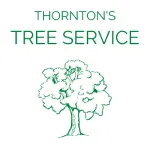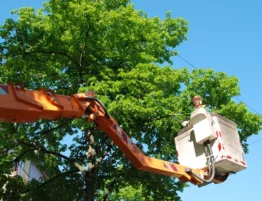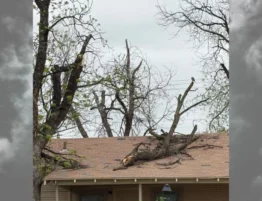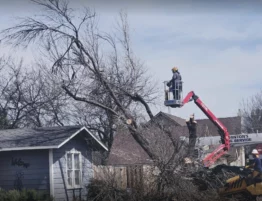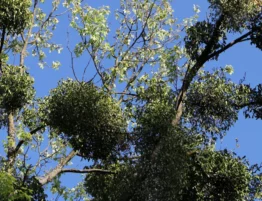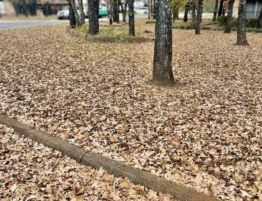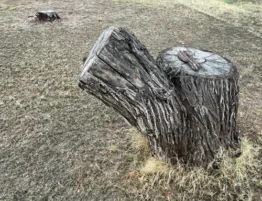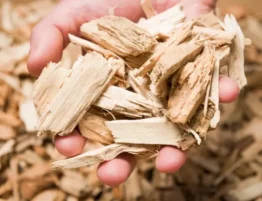Understanding the Difference Between Tree Trimming and Pruning
Though tree trimming and pruning sound similar, they are actually different. Tree trimming is generally performed for aesthetic reasons. This can include shaping the tree or removing dead branches from the tree. On the other hand, pruning is a horticultural practice that is performed in order to promote the health of the tree. This is where diseased or damaged branches are removed, the crown of the tree is thinned out to increase air circulation, or roots are reduced to control the growth of the tree. It’s important to understand the difference between these actions to properly care for your trees.
Types of Tree Trimming
Crown Thinning
Crown thinning is the selective removal of branches to increase light penetration and air movement through the crown. It is generally used on broad-leaved trees, such as oaks, to reduce wind resistance or to allow more light to reach the ground. Crown thinning should not be confused with pruning, which is the removal of entire branches. Instead, crown thinning selectively removes individual branches throughout the crown of the tree. This process is often used to improve the tree’s appearance or to allow more light to reach the ground. In some cases, crown thinning can also help to reduce the weight of the tree’s canopy, which can help to prevent wind damage.
Crown Raising
Tree trimming technique that involves removing lower branches to create more clearance. This can help to improve the tree’s appearance, allow more light to reach the ground, and reduce the risk of damage from falling branches. In addition, crown raising can help to prevent the tree from becoming a nuisance or hazard.
Crown Reduction
Crown reduction involves trimming back the outermost branches of a tree, reducing its overall size. It is used to clear tree branches from objects such as buildings, signs, or outdoor lights. This can help to reduce the risk of storm damage by reducing the tree’s wind resistance. Second, it can prevent the tree from interfering with power lines or other structures.
Crown Restoration
The process of removing damaged or diseased branches from a tree in order to promote new growth. Crown restoration trimming can be beneficial for both young and mature trees. By removing damaged branches, the tree is able to direct its energy toward new growth. This can help the tree to recover from storm damage or disease.
Types of Pruning
Crown Cleaning
Crown cleaning is a type of tree trimming that involves removing dead, diseased or damaged branches from the crown of the tree. This helps to improve the appearance of the tree and promotes its overall health. Crown cleaning is the most basic level of tree pruning and includes the removal of dead, dying, diseased and broken branches.
Removal Cut
Removal cutting is a type of pruning where the goal is to remove a specific branch or stem from a tree. This is usually done to improve the overall appearance of the tree, encourage new growth, or get rid of dead or damaged branches.
Reduction Cut
A reduction cut is a pruning cut that is used to reduce the overall size of a tree. This type of cut is typically made on large branches or stems, and it involves removing a portion of the plant material. Reduction cuts can be used to control the growth of a plant, shape its form, or reduce its weight. With proper care, reduction cuts can help keep your trees looking their best.
Heading Cut
Heading cut pruning is a method of pruning that involves making cuts to the main stem or trunk of a plant. This type of pruning is often used to control the shape and size of a tree or shrub, as well as to encourage denser growth. Heading cut pruning can be done at any time of year, but you may want to avoid it during the hottest part of our summers.
Removing Dead Branches
Regularly removing dead branches from trees not only keeps them looking good, but also helps to promote tree health. Dead branches provide a home for pests and diseases, which can then spread to the rest of the tree. These dead branches are more likely to break off in high winds we experience here in the Abilene, TX and Wichita Falls, TX, Possum Kingdom Lake, and Weatherford, TX areas and cause damage to both the tree and any nearby property. Pruning also allows more sunlight and air to reach the interior of the tree, which can help to prevent mold and fungus growth. Finally, pruning helps to encourage new growth, giving the tree a healthier appearance.
Regular tree care will keep your trees beautiful and healthy. By understanding these differences you can ensure that your trees receive the care they need to thrive here in the rough climate of West Texas.
